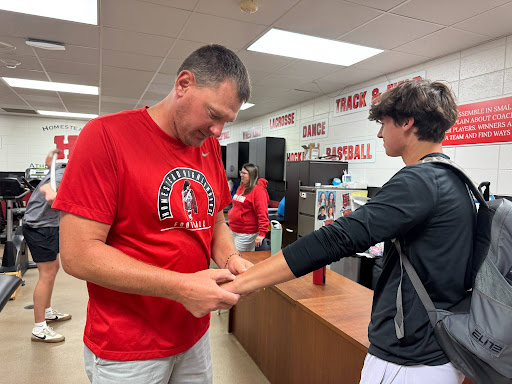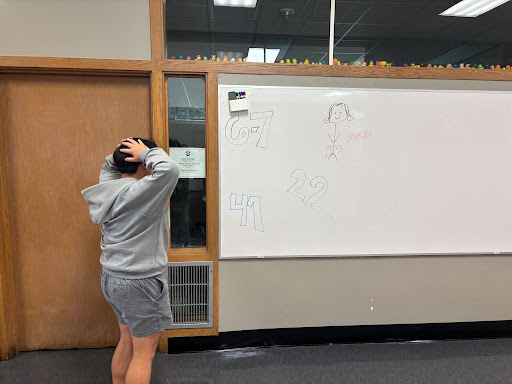Creativity thrives in every corner, from the innovative art installations in the hallways to collaborative projects in the labs. This vibrant atmosphere not only inspires students to explore their artistic capabilities but also fosters a culture of imagination and problem-solving, preparing them for a future where creativity is key to success.
Homestead offers various classes meant to spark creativity in students— an escape from sitting at a desk and listening to lectures. There are many ways creativity can be inspired
One example is Multimedia, taught by Kathleen Connelly.
“The whole multimedia curriculum, I just made it up. There are no textbooks; I created all of the projects from
scratch,” Connelly said. “There was an opportunity for a new class that would only get bigger with the developing software advancements and one that would relate to students.”
In the classroom, there are posters filled with pictures of past students hung on the room’s ceiling. On the first day of the trimester, students pick a picture. Then, students have to write an imaginary story about whatever they think that picture
portrays. “They share it, so it encourages students to take a risk,” Connelly said.
Creativity is best used in the computer lab if students plan their projects and think big.
“I know it’s a trite saying, but think outside the box,” Connelly said.
Students are prompted to use higher levels of thinking skills such as, “Costa’s Levels of Thinking.”
Multimedia is a creative and very fun class, if there is any doubt “just ask your peers and any alumni that have taken the class,” Connelly said.
“If there is one thing for certain, students will walk out of my class having gained life skills to help them in their futures,” Connelly added.
Multivariable and Calculus BC are both taught by Wolfgang Recht.
He recounts, “I have always liked math, but my senior year I had a calculus teacher who was very good at explaining things. Calculus just sort of clicked and started really making sense to me.”
“My goal coming in is that every student that steps in has the ability to be successful,” Recht said.
Many students set up roadblocks for themselves with the mentality that they are bad at math.
Recht’s goal is to help students see past that and to see success early which leads to success in the future.
Creativity is a priority in Recht’s classroom.
Recht explains, “I could give a question to four different students and they might see four different ways on how to
get their answer at the end. And as long they are doing legal math moves, theres a lot of different avenues to get the solution. Math is not as cut and dry as it may seem.”
The teaching style Recht has found effective is giving kids an opportunity to talk through problems with their peers.
“In an activity the students did today, each one had a chance to be the leader of the group. But in the meantime, three or four other voices are being heard to help talk through the problem.”
“It is high-level math, but if you come in with that open mindset of—you can achieve difficult tasks—then you can definitely have success.”
Lastly, Jeff Patterson’s stem lab epitomizes creativity.
“The goals of my classes are for students to be able to utilize the content and apply it to a problem,” Patterson said.
“The idea of problem-solving is that there is no one correct answer, and there are multiple ways to get to a solution.”
Patterson stated, “I wanted to be a band director, but that fizzled out because I didn’t have the passion required. After that, I flipped to premed because I am good at science and like solving problems. I also like puzzles, things that require analysis, and looking at data. I had a friend who said I was a good tutor for science and said that the
educational field might be a good idea, so here I am.”
Stem classes expose students to different ideas aside from required classes. There is a lot of diversity in STEM classes in terms of things you can pursue.
“I hate lifes cience; it’s just not for me. But I found the STEM topics I really enjoy,” Patterson said.
STEM classes are hands-on and are unique to regular science and math classes.
“There is lots of 3-D modeling in Intro to Engineering Design and at times it feels like it could be an art class because of how much creative design is put into it,” Patterson said.
There are so many ways that creativity can be inspired in students. Teachers play a big role in this because they have all experienced some form of needed creativity leading to their successful careers and futures.







